Order-5 octahedral honeycomb
In the geometry of hyperbolic 3-space, the order-5 octahedral honeycomb is a regular space-filling tessellation (or honeycomb) with Schläfli symbol {3,4,5}. It has five octahedra {3,4} around each edge. All vertices are ultra-ideal (existing beyond the ideal boundary) with infinitely many octahedra existing around each vertex in an order-5 square tiling vertex arrangement.
| Order-5 octahedral honeycomb | |
|---|---|
| Type | Regular honeycomb |
| Schläfli symbols | {3,4,5} |
| Coxeter diagrams | |
| Cells | {3,4} |
| Faces | {3} |
| Edge figure | {5} |
| Vertex figure | {4,5} 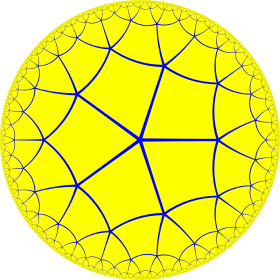 |
| Dual | {5,4,3} |
| Coxeter group | [3,4,5] |
| Properties | Regular |
Images
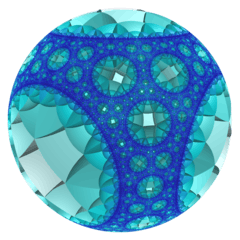 Poincaré disk model (cell centered) |
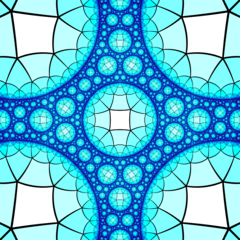 Ideal surface |
Related polytopes and honeycombs
It a part of a sequence of regular polychora and honeycombs with octahedral cells: {3,4,p}
| {3,4,p} polytopes | |||||||||||
|---|---|---|---|---|---|---|---|---|---|---|---|
| Space | S3 | H3 | |||||||||
| Form | Finite | Paracompact | Noncompact | ||||||||
| Name | {3,4,3} |
{3,4,4} |
{3,4,5} |
{3,4,6} |
{3,4,7} |
{3,4,8} |
... {3,4,∞} | ||||
| Image |  |
 |
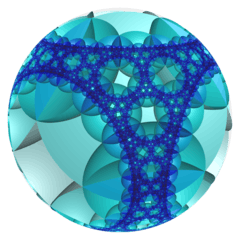 |
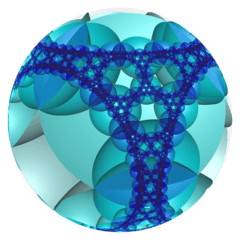 |
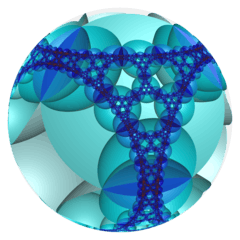 |
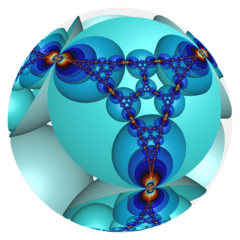 | |||||
| Vertex figure |
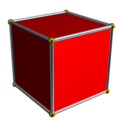 {4,3} |
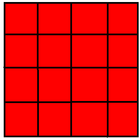 {4,4} |
 {4,5} |
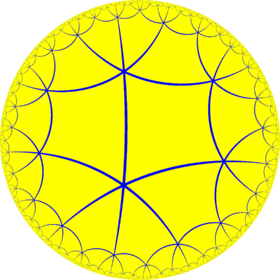 {4,6} |
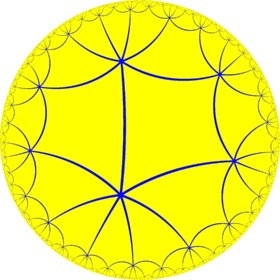 {4,7} |
 {4,8} |
 {4,∞} | ||||
Order-6 octahedral honeycomb
| Order-6 octahedral honeycomb | |
|---|---|
| Type | Regular honeycomb |
| Schläfli symbols | {3,4,6} {3,(3,4,3)} |
| Coxeter diagrams | |
| Cells | {3,4} |
| Faces | {3} |
| Edge figure | {6} |
| Vertex figure | {4,6} {(4,3,4)} |
| Dual | {6,4,3} |
| Coxeter group | [3,4,6] [3,((4,3,4))] |
| Properties | Regular |
In the geometry of hyperbolic 3-space, the order-6 octahedral honeycomb is a regular space-filling tessellation (or honeycomb) with Schläfli symbol {3,4,6}. It has six octahedra, {3,4}, around each edge. All vertices are ultra-ideal (existing beyond the ideal boundary) with infinitely many octahedra existing around each vertex in an order-6 square tiling vertex arrangement.
 Poincaré disk model (cell centered) |
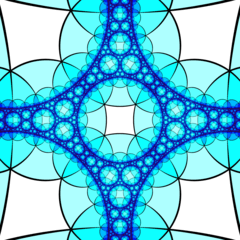 Ideal surface |
It has a second construction as a uniform honeycomb, Schläfli symbol {3,(4,3,4)}, Coxeter diagram, ![]()
![]()
![]()
![]()
![]()
Order-7 octahedral honeycomb
| Order-7 octahedral honeycomb | |
|---|---|
| Type | Regular honeycomb |
| Schläfli symbols | {3,4,7} |
| Coxeter diagrams | |
| Cells | {3,4} |
| Faces | {3} |
| Edge figure | {7} |
| Vertex figure | {4,7} |
| Dual | {7,4,3} |
| Coxeter group | [3,4,7] |
| Properties | Regular |
In the geometry of hyperbolic 3-space, the order-7 octahedral honeycomb is a regular space-filling tessellation (or honeycomb) with Schläfli symbol {3,4,7}. It has seven octahedra, {3,4}, around each edge. All vertices are ultra-ideal (existing beyond the ideal boundary) with infinitely many octahedra existing around each vertex in an order-7 square tiling vertex arrangement.
 Poincaré disk model (cell centered) |
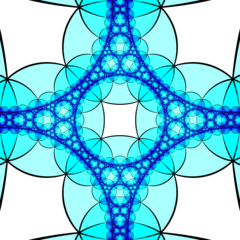 Ideal surface |
Order-8 octahedral honeycomb
| Order-8 octahedral honeycomb | |
|---|---|
| Type | Regular honeycomb |
| Schläfli symbols | {3,4,8} |
| Coxeter diagrams | |
| Cells | {3,4} |
| Faces | {3} |
| Edge figure | {8} |
| Vertex figure | {4,8} |
| Dual | {8,4,3} |
| Coxeter group | [3,4,8] |
| Properties | Regular |
In the geometry of hyperbolic 3-space, the order-8 octahedral honeycomb is a regular space-filling tessellation (or honeycomb) with Schläfli symbol {3,4,8}. It has eight octahedra, {3,4}, around each edge. All vertices are ultra-ideal (existing beyond the ideal boundary) with infinitely many octahedra existing around each vertex in an order-8 square tiling vertex arrangement.
 Poincaré disk model (cell centered) |
Infinite-order octahedral honeycomb
| Infinite-order octahedral honeycomb | |
|---|---|
| Type | Regular honeycomb |
| Schläfli symbols | {3,4,∞} {3,(4,∞,4)} |
| Coxeter diagrams | |
| Cells | {3,4} |
| Faces | {3} |
| Edge figure | {∞} |
| Vertex figure | {4,∞} {(4,∞,4)} |
| Dual | {∞,4,3} |
| Coxeter group | [∞,4,3] [3,((4,∞,4))] |
| Properties | Regular |
In the geometry of hyperbolic 3-space, the infinite-order octahedral honeycomb is a regular space-filling tessellation (or honeycomb) with Schläfli symbol {3,4,∞}. It has infinitely many octahedra, {3,4}, around each edge. All vertices are ultra-ideal (existing beyond the ideal boundary) with infinitely many octahedra existing around each vertex in an infinite-order square tiling vertex arrangement.
 Poincaré disk model (cell centered) |
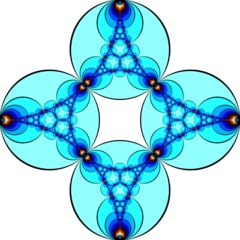 Ideal surface |
It has a second construction as a uniform honeycomb, Schläfli symbol {3,(4,∞,4)}, Coxeter diagram, ![]()
![]()
![]()
![]()
![]()
![]()
![]()
![]()
![]()
![]()
![]()
![]()
![]()
See also
- Convex uniform honeycombs in hyperbolic space
- List of regular polytopes
References
- Coxeter, Regular Polytopes, 3rd. ed., Dover Publications, 1973. ISBN 0-486-61480-8. (Tables I and II: Regular polytopes and honeycombs, pp. 294–296)
- The Beauty of Geometry: Twelve Essays (1999), Dover Publications, LCCN 99-35678, ISBN 0-486-40919-8 (Chapter 10, Regular Honeycombs in Hyperbolic Space) Table III
- Jeffrey R. Weeks The Shape of Space, 2nd edition ISBN 0-8247-0709-5 (Chapters 16–17: Geometries on Three-manifolds I,II)
- George Maxwell, Sphere Packings and Hyperbolic Reflection Groups, JOURNAL OF ALGEBRA 79,78-97 (1982)
- Hao Chen, Jean-Philippe Labbé, Lorentzian Coxeter groups and Boyd-Maxwell ball packings, (2013)
- Visualizing Hyperbolic Honeycombs arXiv:1511.02851 Roice Nelson, Henry Segerman (2015)
External links
- John Baez, Visual insights: {7,3,3} Honeycomb (2014/08/01) {7,3,3} Honeycomb Meets Plane at Infinity (2014/08/14)
- Danny Calegari, Kleinian, a tool for visualizing Kleinian groups, Geometry and the Imagination 4 March 2014.